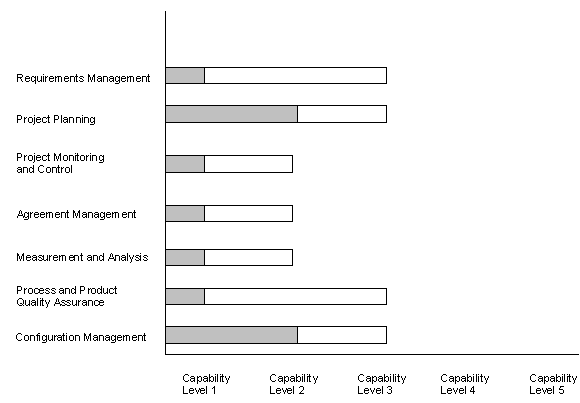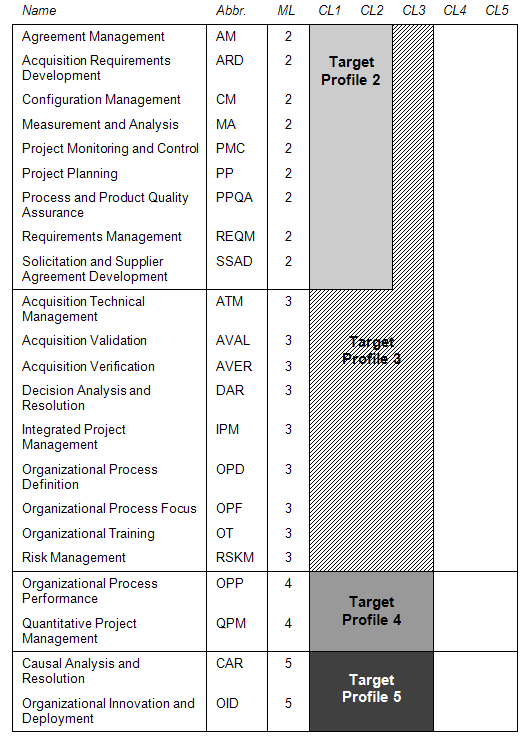Equivalent staging is a way to compare results from using the continuous representation to those of the staged representation. In essence, if you measured improvement relative to selected process
areas using capability levels in the continuous representation, how would you compare that to maturity levels? Is this possible?
Up to this point, we have not discussed process appraisals in much detail. The SCAMPISM method[1] is used to appraise organizations using CMMI, and one result of an appraisal is a rating [SEI 2006b, Ahern 2005]. If the continuous representation is used for an appraisal, the rating is a capability level
profile. If the staged representation is used for an appraisal, the rating is a maturity level (e.g., maturity level 3) rating.
A capability level profile is a list of process areas and the corresponding capability level achieved for each. This profile enables an organization to track its capability level by process area.
The profile is an achievement profile when it represents the organization's actual progress for each process area. Alternatively, the profile is a target profile when it represents the
organization's planned process improvement objectives. Figure 3.3 illustrates a combined target and achievement profile. The gray portion of each bar represents what has been achieved. The unshaded portion represents what remains to be accomplished to
meet the target profile.

Figure 3.3: An Example of a Target and Achievement Profile
An achievement profile, when compared with a target profile, enables an organization to plan and track its progress for each selected process area. Maintaining capability level profiles is advisable
when using the continuous representation.
Target staging is a sequence of target profiles that describes the path of process improvement to be followed by the organization. When building target profiles, the organization should pay
attention to the dependencies between generic practices and process areas. If a generic practice depends on a process area, either to carry out the generic practice or to provide a prerequisite product, the generic practice may be much less effective when
the process area is not implemented.[2]
Although there are many reasons to use the continuous representation, ratings consisting of capability level profiles are limited in their ability to provide organizations with a way to generally
compare themselves with other organizations. Capability level profiles could be used if each organization selected the same process areas; however, maturity levels have been used to compare organizations for years and already provide predefined sets of
process areas.
Because of this situation, equivalent staging was created. Equivalent staging enables an organization using the continuous representation for an appraisal to convert a capability level profile to
the associated maturity level rating.
The most effective way to depict equivalent staging is to provide a sequence of target profiles, each of which is equivalent to a maturity level rating of the staged representation. The result is a
target staging that is equivalent to the maturity levels of the staged representation.
Figure 3.4 shows a summary of the target profiles that must be achieved when using the continuous representation to be equivalent to maturity levels 2 through 5. Each shaded area in the
capability level columns represents a target profile that is equivalent to a maturity level.

Figure 3.4: Target Profiles and Equivalent Staging
The following rules summarize equivalent staging:
· To achieve maturity level 2, all process areas assigned to maturity level 2 must achieve capability level 2 or higher.
· To achieve maturity level 3, all process areas assigned to maturity levels 2 and 3 must achieve capability level 3 or higher.
· To achieve maturity level 4, all process areas assigned to maturity levels 2, 3, and 4 must achieve capability level 3 or higher.
· To achieve maturity level 5, all process areas must achieve capability level 3 or higher.
These rules and the table for equivalent staging are complete; however, you may ask why target profiles 4 and 5 do not extend into the CL4 and CL5 columns. The reason is that maturity level 4
process areas describe a selection of the subprocesses to be stabilized based, in part, on the quality and process-performance objectives of the organization and projects. Not every process area will be addressed in the selection and CMMI does not
presume in advance which process areas might be addressed in the selection.
So, the achievement of capability level 4 for process areas cannot be predetermined because the choices depend on the selections made by the organization in its implementation of the maturity
level 4 process areas. Thus, Figure 3.4 does not show target profile 4 extending into the CL4 column, although some process areas will have achieved capability level 4. The situation for maturity level 5 and target profile 5 is
similar.
The existence of equivalent staging should not discourage users of the continuous representation from establishing target profiles that extend above capability level 3. Such a target profile
would be determined in part by the selections made by the organization to meet its business objectives.
The Standard CMMI Appraisal Method for Process Improvement (SCAMPI) method is described in Chapter 5.
See Table 6.2 in the Generic Goals and Generic Practices section of Part Two for more information about the dependencies between generic practices and
process areas.